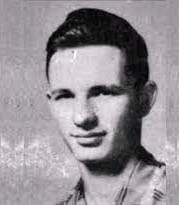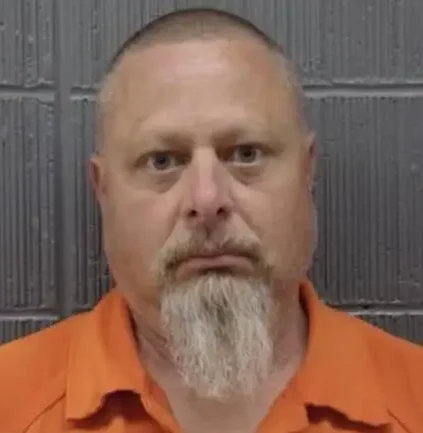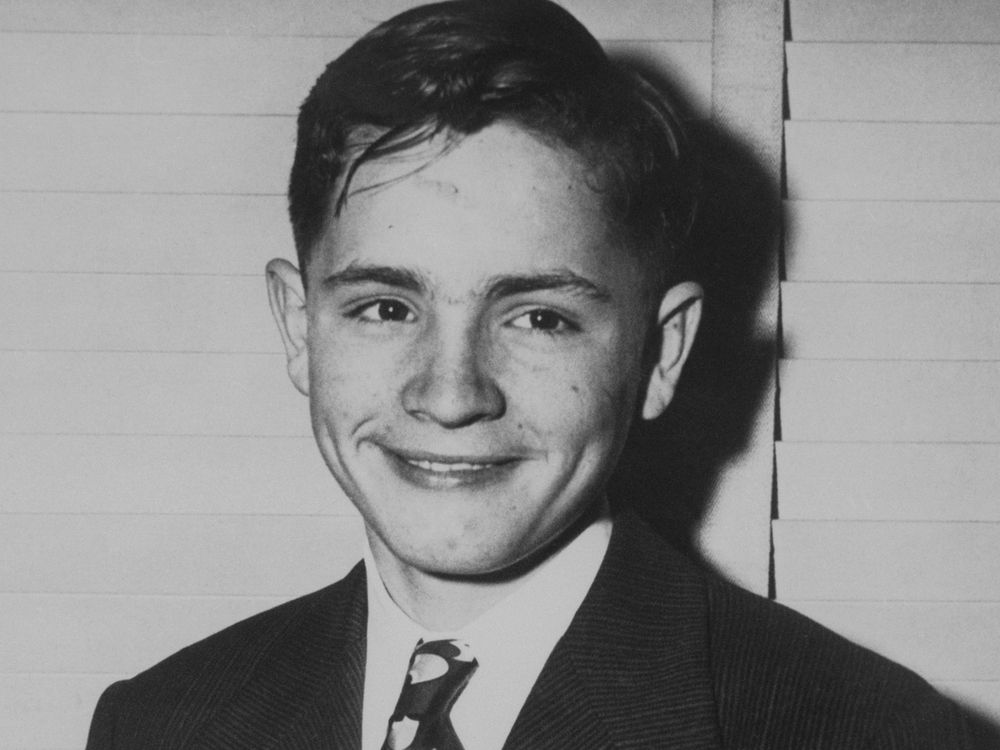
Charles Manson was abandoned by his mother and never knew his father. He was never the object of anyone’s even distant affection. His birth mother, Kathleen Maddox, was sixteen when he was born. She was either promiscuous or a prostitute or both, disappearing for days at a time and leaving Charles with a grandmother or with his very strict aunt. Kathleen was later married briefly to William Manson. When Manson was five, Kathleen was sent to prison for armed robbery. Upon release she was unwilling to accept responsibility for him and actually traded him for a glass of beer. Friendless, Manson stole and was sent at nine to a reformatory from which he escaped. He spent the last part of his childhood and all of his adolescence in and out of jails and institutions.
While incarcerated, he was sodomized, according to what Manson related, by men much larger than himself. Also, according to him, many of them were black which moved blacks to the top of his hate list. Released at twenty-four, he pimped for a time. He was rearrested a year later. Then two years later he was put back in prison for rape, drug use, pimping, stealing, and fraud. Manson stated some years later, when he was thirty-two and released from prison again, that he knew he could not adjust to the outside world, having spent all of his life locked up.
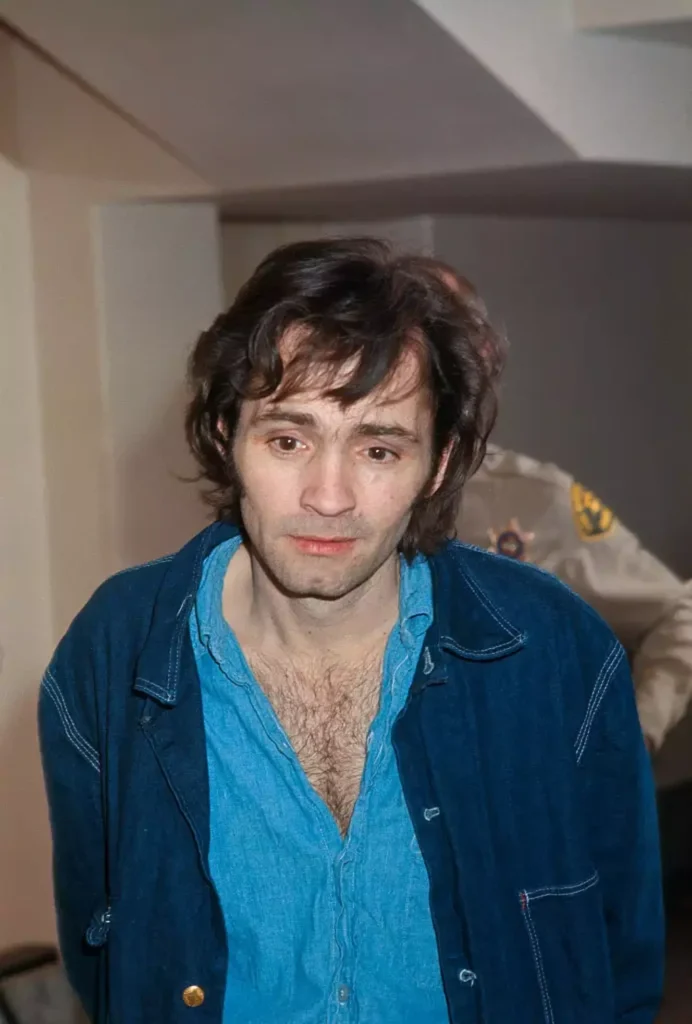
Shortly after, he became Manson we know – the cult leader and supreme con artist, meantime exercising sexual privileges with the young women. Admittedly, the formative years in Manson’s life were so shorn of all humanizing influences that it is impossible to gauge to what extent heredity may have contributed to his early antisocial behavior and his lasting psychopathy. He was later diagnosed with paranoid schizophrenia. His paranoia and other psychotic-like traits were firmly embedded within a wider picture of psychopathy and mind altering drug use. He seemed utterly deluded, but he was an adept con artist who, while in McNeil Island Penitentiary in the 1960’s, had absorbed ideas about interpersonal influence and manipulation from inmates steeped in hypnotism. Scientology, psychology, and the idea of Dale Carnegie about how to win over other people. He was mimicking their body language as a part of the session. Manson further disintegrated his followers’ personal identities by drugging them with LSD and constantly barraging them with pseudo-spiritual rhetoric, claiming that he was Jesus, God and the devil. He also convinced them that the “four angels” mentioned in the Book of the Apocalypse were incarnated as the four members of the rock band “The Beatles”. The Beatles wrote a song called “Helter Skelter.” He distorted lyrics to fit in with his warped notion of Armageddon, which in his mind consisted of an uprising by the blacks to take over the world. When the great race war arrived, he called “Helter Skelter”, they would survive it by going underground and building up a population of 144 000 cult members, who would later reemerge and dominate the world. It was when he noticed that this Armageddon wasn’t happening all by itself that he decided to carry out murders by getting a few of his most loyal and like himself – totally amoral followers to murder some high-profile and noticeably wealthy people in the white community. Manson hated wealthy people, black people, Jews, gays. He blamed society in general for his poor upbringing and his treatment in institutions. He blamed society for his life.

The spree murders organized by Charles Manson in Los Angeles in 1969 of Gary Hinman on July 31, actress Sharon Tate (eight months pregnant) and four others at her house on August 9, and of the LaBianca a couple of days later are unique in that that Charles Manson was not present. He amassed a group of followers, called “family” and ordered them to carry out the murders.
No serious scientist would analyze this phenomenon in a vacuum. 1960 – The contraceptive “pill” become available. 1963 – Use of marijuana become widespread; other drugs are sometimes added to the mix, including LSD, amphetamines, and, to a lesser extent, cocaine. 1964 – Dr. Timothy Leary’s message of “Tune in, turn on, drop out” helped accelerate the burgeoning drug epidemic. 1965 – Soaring divorce rate in the United States; high incarceration rate of boys born to unwed mothers. 1966 – Sudden upsurge of serial sexual homicide and mass murder in the United States, after decades of very low yearly incidence. An upsurge in examples of outré sexual license (freedom to engage in sexual activity without moral restraint) in forms such as Plato’s Retreat orgies (swinger orgies), wife swapping, and “key” (parties attendees would pick keys out of a bowl and go home with whoever’s keys they picked). Emergence of militant black groups on the Far Left. Liberation of black people. 1969 – The Stonewall Riots launch the gay liberation movement. Civil unrest, student riots, protests against US involvement in Vietnam war, “hippies” burn draft cards, increase in violent crime, especially robberies and assaults. Every liberation goes to extreme at first, until some balance is found, and that happened with sexual and racial liberation. Giving the fact that women hadn’t had the right prior to this decade to work, to choose their partners, to divorce, so breaking the social chains was, as expected, extreme. Young people also wanted their rights and they protested against wars, promoting love, free love. Maybe good example is if you are tied up, in chains, and you break free, you will not walk casually, but run the fastest you can.
For someone like Charles Manson it was easy to fit in and find suitable followers.
Who were Manson’s followers?

Tex Watson, 24, was a central member of the “Manson Family”. Watson grew up attending church locally, and was an honor student, editor on the school paper, and captain of the football team, and set a record for the high hurdles at Farmersville High School. He visited a fraternity brother in Los Angeles. There he became interested in the psychedelic and music lifestyle of the late 1960s. While driving one day, Watson picked up a hitchhiker, Dennis Wilson of The Beach Boys, and drove him to Wilson’s house. There he was first introduced to the Manson Family who lived with Wilson.

Watson lived with the Manson Family at Spahn Ranch for nine months before the crimes, becoming close to Manson. Following Manson’s orders to “find money for Helter Skelter”, Watson contrived to steal money from his lover’s friend, Bernard Crowe. Crowe called the ranch, spoke to Manson and told him he would come to the ranch and kill everyone if he did not get his money back. In response, Manson shot Crowe in the stomach, using the same pistol that Watson would use in the Tate murders.
On August 9, 1969, Watson led Susan Atkins, 21, Linda Kasabian, 20, and Patricia Krenwinkel, 22, to the home of Roman Polanski and Sharon Tate in Los Angeles. They murdered all four people inside the house, and also Steven Parent in the driveway. Watson and his crime partners inflicted 28 stab wounds to one victim, Abigail Folger, alone.

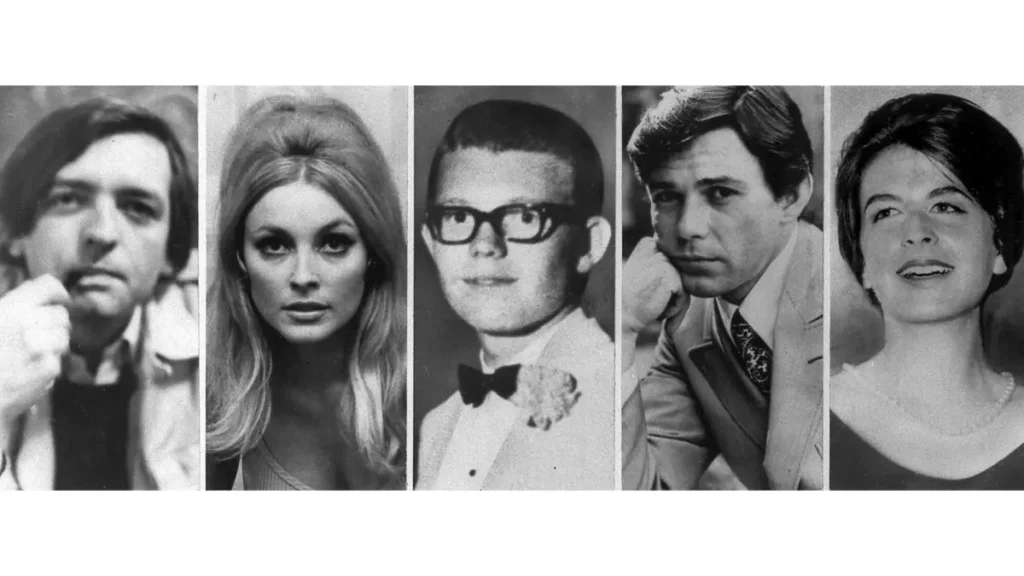
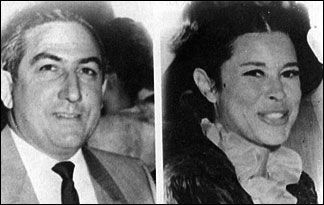
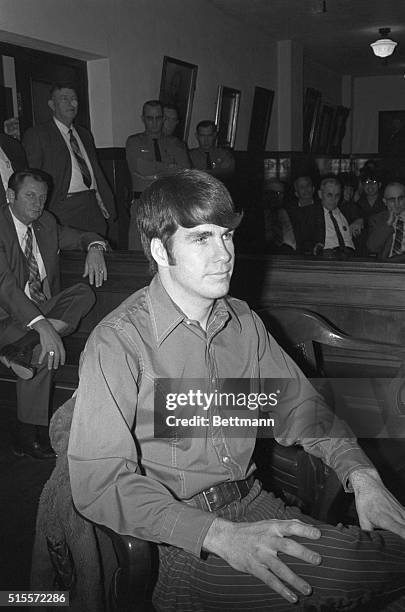
Watson was convicted of murder in 1971 and sentenced to death. As a result of a 1972 California Supreme Court decision on the constitutionality in the state of the death penalty, he avoided execution but has remained incarcerated ever since.
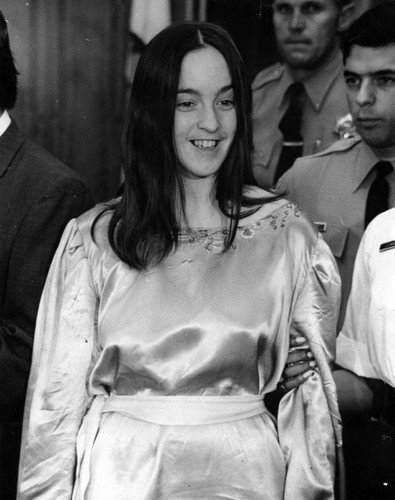
Susan Atkins was convicted for her participation in eight of these killings, including the most notorious, the Tate murders in 1969. She was sentenced to death, which was subsequently commuted to life imprisonment. According to Atkins, her parents were alcoholics. Two weeks before her mother was hospitalized for the final time, Susan arranged for members of the church choir to sing Christmas carols under her bedroom window. In early 1967 she was working as a stripper in Los Angeles, and Anton LaVey hired her for a performance. Later in 1967, Atkins met Manson when he played guitar at the house where she was living with several friends. When the house was raided several weeks later by the police and Atkins was left homeless, Manson invited her to join his group, who were embarking on a summer road trip in a converted school bus painted completely black. Atkins later claimed to have believed Manson was Jesus. The growing “Manson Family” settled at the Spahn Ranch in the San Fernando Valley in southern California, where, on October 7, 1968, Atkins bore a son by Bruce White, whom Manson called Zezozose Zadfrack Glutz. Atkins’s parental rights were terminated once she was convicted of the murders, and no one in her family would assume responsibility for the child. Her son was adopted and renamed from the time of her incarceration in 1969. She had no further contact with him. During the summer of 1969, Manson and his commune at Spahn’s Ranch were attracting the attention of the police, who suspected them of auto thefts and were suspicious of the high number of underage runaways. Manson sent Atkins, Bobby Beausoleil, and Mary Brunner to Hinman’s home on July 25, 1969. When Hinman said that he had not inherited any money, Beausoleil beat him severely. When Hinman still insisted that he had no inheritance, Manson showed up in person and swung at his head with a sword, slicing his face and severely cutting his ear. Manson directed Atkins and Brunner to stay behind and tend to Hinman’s wounds. Two days later, and after a phone call from Manson, Beausoleil had Hinman sign over the registrations to his cars and then fatally stabbed him twice. Beausoleil left a bloody hand print on the wall along with the words “Political Piggy” reportedly placed there in hopes of implicating the Black Panthers. Beausoleil was arrested on August 7, 1969, when he was found asleep in one of Hinman’s vehicles. He was still wearing the bloodstained clothing he wore during the crime. The murder weapon was hidden in the tire well of the car’s trunk. Atkins wrote “PIG” on the front door in Sharon Tate’s blood. Atkins stated that she wanted to do a crime that would shock the world.
On August 16, 1969, the police raided Spahn’s Ranch in connection with auto thefts. The charges were later dropped and everyone was released. Soon after their release, Manson and his followers left Spahn Ranch for Barker Ranch, another isolated location. However, the authorities were still suspicious of the group, raided the new location in October 1969, and arrested the group again on auto theft charges. It would be the last time many of them would be free. Just after this arrest, another member of the group implicated Atkins in the Hinman murder and she was charged with that crime. While in jail, Atkins befriended two middle-aged career criminals to whom she confessed her participation in the Tate/LaBianca murders (for example, telling the women that she had stabbed Tate and tasted Tate’s blood). They subsequently reported her statements to the authorities. This, combined with information from other sources, led to the arrests of Atkins and others involved in the Tate/LaBianca murders (Van Houten, Krenwinkel, Kasabian, and Watson).
Atkins agreed to testify for the prosecution, in exchange for the State of California not seeking the death penalty against her. Atkins appeared before a grand jury, and provided extensive testimony concerning the events on the nights of August 8 and 9, 1969. Atkins told the grand jury that she stabbed Frykowski in the legs and held Tate down while Watson stabbed her. She also testified that Tate had pleaded for her life and that of her unborn child. In response, Atkins replied, “Woman, I have no mercy for you.” She told the grand jury that her words were intended to reassure herself, and not addressed to Tate. Atkins also denied her earlier statement to Howard and Graham that she had tasted Tate’s blood. However, Atkins herself later gave a slightly different account of the crimes. In a 1976 interview, after she had become a born-again Christian, Atkins claimed that she did not actually stab anyone during the Tate murders, and that Watson was responsible for the murder of Sharon Tate. In his 1978 memoir, Watson declared himself responsible for all of Tate’s injuries, characterizing Atkins’s initial confessions as exaggeration, jail house bragging, and a bid for attention. Susan Atkins died in 2009.

Patricia Krenwinkel was often bullied at school by other students, suffered from low self-esteem, and was frequently teased for being overweight and for an excessive growth of body hair caused by an endocrine condition. She decided to attend the Jesuit college Spring Hill College in Mobile, Alabama. Within one semester, however, she dropped out and moved back to California. Moving into her half-sister’s apartment in Manhattan Beach, she found an office job as a processing clerk. She met Charles Manson in Manhattan Beach in 1967, along with Lynette Fromme and Mary Brunner. In later interviews, Krenwinkel stated that she had sex with Manson the first night they met, and that he was the first person who told her she was beautiful. Mesmerized by Manson’s charisma and starved for attention, she decided to go to San Francisco with him and the other two girls, leaving behind her apartment, car, and last paycheck. As the Manson Family grew, Krenwinkel and the others went on a drug- and sex-filled 18-month tour of the American west in an old school bus. She would later recount an idealized version of The Family’s early days: “We were just like wood nymphs and wood creatures. We would run through the woods with flowers in our hair, and Charles would have a small flute”. Krenwinkel was a participant in the murders on August 9, of actress Sharon Tate and four others. After stabbing Abigail Folger, Krenwinkel went back inside and summoned Tex Watson, who also stabbed Folger. During her trial, Krenwinkel said, “I stabbed her and I kept stabbing her.” When asked how it felt, Krenwinkel replied: “Nothing, I mean, what is there to describe? It was just there, and it was right.” Following the 2009 death of fellow Manson cult member Susan Atkins, Krenwinkel is now the longest-incarcerated female inmate in the California penal system.

Linda Kasabian was present at both the Tate–LaBianca murders committed by the cult members in 1969, but received legal immunity for her testimony as a key witness in District Attorney Vincent Bugliosi’s prosecution of Manson and his followers. As a child, Kasabian was described by friends, neighbors, and teachers as intelligent, a good student but a “starry-eyed romantic”. She was regarded as kind and shy but “forced to grow up too soon”. She dropped out of high school and ran away from home at the age of sixteen due to conflict with her stepfather. Kasabian traveled to the West Coast, “looking for God”. At the age of 16, she married Robert Peaslee, a high school classmate, but divorced a short time later. She briefly moved to Miami and tried to reconnect with her father, who was working as a bartender, but they again drifted apart before long. She then traveled to Boston, remarried, and gave birth to a daughter in 1968. By the time she became pregnant with her second child, Kasabian was feeling neglected by her husband Robert Kasabian, who had ultimately left her behind for the South American sailing trip. She met Catherine Share, who told Kasabian about an idyllic ranch outside Los Angeles where a commune of hippies were establishing a “hole in the earth” paradise to escape an anticipated race war which they referred to as “Helter Skelter.” Kasabian was then introduced to Manson. According to Kasabian, she thought he looked magnificent in his buckskin clothing, and that he seemed to be Christ-like.nManson talked with her about why she had come to the ranch, and after “feeling her legs”, he accepted her. That night, Manson and Kasabian had sex in a Spahn Ranch cave. She thought that Manson could “see right through her” and that he was perceptive of her issues with her stepfather and her feelings of being “disposable” to the people in her life and to the world in general. Kasabian stated she saw Watson shoot and kill Steven Parent, a teenager who had come to visit the caretaker, William Garettson. Watson then ordered Kasabian to remain outside the residence, and she stood by the car while Watson, Atkins, and Krenwinkel entered the house and killed Jay Sebring, Wojciech Frykowski, Abigail Folger, and the eight-months pregnant Sharon Tate.


Leslie Van Houten was considered to be the least devoted to Manson, it was anticipated by some that she would receive a lenient sentence. However, she repeatedly disrupted the trial proceedings with giggling, particularly during discussion of the murders. She also showed little remorse at the time, saying: “Sorry is only five-letter word.” She stabbed Mrs. LaBianca who was already dead. By the late 1970’s, Van Houten was considered to undergone a significant personal change. She underwent decades of psychotherapy to attempt to learn how she fell under Manson’s mind control. She has long expressed remorse and renounced Manson. On May 30, 2023, a California Court of Appeal in Los Angeles set aside Governor Newsom’s denial of Van Houten’s parole, thus making her the first Manson family member to have a court rule in her favor for a parole recommendation. On July 7, 2023, Governor Newsom announced that he would not file an appeal with the California Supreme Court to block her parole, paving the way for her release. Van Houten was released on parole on July 11, 2023, after serving over 52 years in prison. To date, Krenwinkel and Watson remain imprisoned.
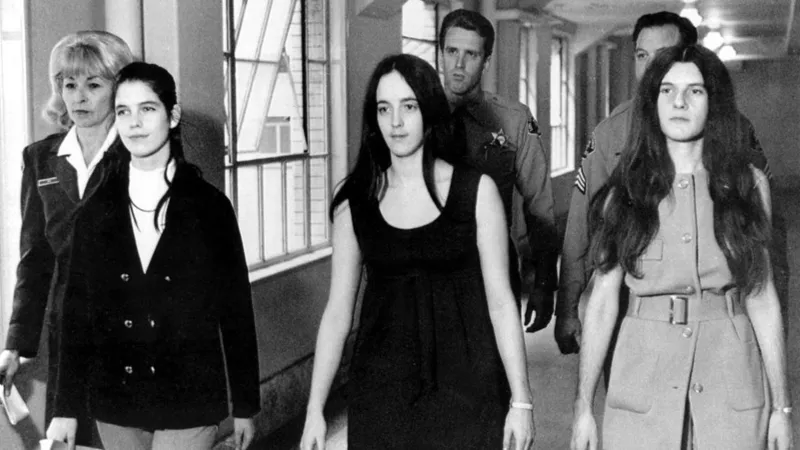
think you are one. – Yeah, it would reflect, if you hold a negative up to the light. You don’t see the light, you just see the negative, so I’m a reflection of your negative. There’s no doubt about that and I can handle that. Also, I’ve been Hamlin Dana. – I don’t know, have you? – Well, I’ve been up and down these damn hallways, you know, these nut wards for the last ten years. You think you could follow that act? I’m playing for my life. Are you working for money? – When you say you’re playing for your life, am I to assume that you think that some day you’re gonna get out of here? – (laughing) Get out of here? Hm… Get out of here? Where would I go, let see… – What would you do if you got out of here? What if they said to you tomorrow morning ‘Charles, hey, listen, you’re free, you go wherever you want to go, do whatever you want to do? What would you do? – I’ll probably go out and sit down-The question is should Manson ever go free. It’s ten years now since he and his three female accomplices, virtually robots under his control, were convicted of murder on August the 9th 1969. They murdered actress Sharon Tate and four other people in Los Angeles. The following night there were two more victims, Leno and Rosemary LaBianca. In court Manson was also charged with two more mutilation murders. Ranch Hand, Donald Shea was beheaded. A musician Gary Hinman had his ear cut off. According to some accounts, Manson and his family may have been responsible for as many as 35 killings. – If you got out of here, there are a lot of people who think you’d go start killing people again. – Again? Before, you guys’d misinformed. I hadn’t killed anyone. I didn’t break the law. Judge knew that but people didn’t want to hear it. The judge knew it. He washed his hands. He said I don’t know it, but what can I do… – The judge never said… – That’s what all said. – No, judge didn’t say that. – He got off and shook the hands, didn’t it? You’re so white and pure? – Judge didn’t say you were innocent. – Are you innocent? – Innocent of what? – No, that’s what I’m saying. – None of us are innocent. – Yeah, just because you’re convicted in a courtroom doesn’t mean you’re guilty of something. – What does mean you’re guilty? – Well, you know, you’re guilty… – What about Shave? – What about him? – Well what about it? – We got killed. –Well, the word is you killed him. – Where it is you have turkey and sky. Where it is… I don’t know what word. Somebody else tell you that, I didn’t tell you. Did you kill Shea? – Hell, no. – Did you cut his ear? – Hell, yes. – How did that feel when you cut his ear off? what did it feel like? – Yeah. Well, I had done what he said for about 20 years. I’ve done everything he told me to do and I got to thinking now, why don’t this guy do something I tell him to do? And he said no. I said ‘well how comes I’m always doing what you tell me to do but then you never do what I say to?’ And he said ‘well, blah, blah, blah’, so I said ‘now you do what I say’ and he said ‘no’. I said you ‘do exactly what I say’ and he said ‘no’. ‘I’m telling you! I’m not asking you, I’m telling you! You do exactly what I said,’ and that’s about the extent of it all. It’s all called all that hocus-pocus stuff that you guys are playing, I don’t know nothing about all that. – You know nothing about something called Helter Skelter? Tell me, Charles, I don’t know? – It’s a fairy. It’s worse than a fairy. – It’s a fairytale. – It’s a comedy. It’s a comedy-tragedy. – The body of Sharon Tate is make-believe that’s… – That’s make-believe, that’s make-believe to the people that went in there and did what they did. – And who are those people? You know. – Yeah. – But you know who they were. – Sure I know who… – They were with you at the Spahn Ranch. They were part of this thing called, if not the Manson Family or the Manson culty, the Manson ranch, call it… – So and? What? You dealt the hand down in LA, you and that press. You dealt the hand. You put me on Life magazine, had me convicted before I walked in the courtroom. You had what people wanted to buy, when they wanted to buy. It they didn’t give a damn – had to convict a district attorney that had convicted the whole building to get that dollar bill… – Did you go in and tie up LaBiancas? Very simple question. (dodging the question, silence…) – Did I kill anyone? – Did you tie up LaBiancas? – I had a great family and I was the following and leaders and all that. There weren’t followers and leaders. They’re just bunch of kids out the ranch playing. …
Manson died of cardiac arrest in 2017, at the age of eighty-three. He took no real responsibility for his role in the killings.
There’s been a lot of speculation that Manson was subjected to MKUltra, but except claims, I haven’t been able to verify it. Project MKUltra was a human experimentation program designed and undertaken by the U.S. Central Intelligence Agency (CIA) to develop procedures and identify drugs that could be used during interrogations to weaken individuals and force confessions through brainwashing and psychological torture. The term MKUltra is a CIA cryptonym: “MK” is an arbitrary prefix standing for the Office of Technical Service and “Ultra” is an arbitrary word out of a dictionary to denominate this project.
Some suggested that his small stature and other physical features point towards Fetal alcohol spectrum disorders (FASD).
